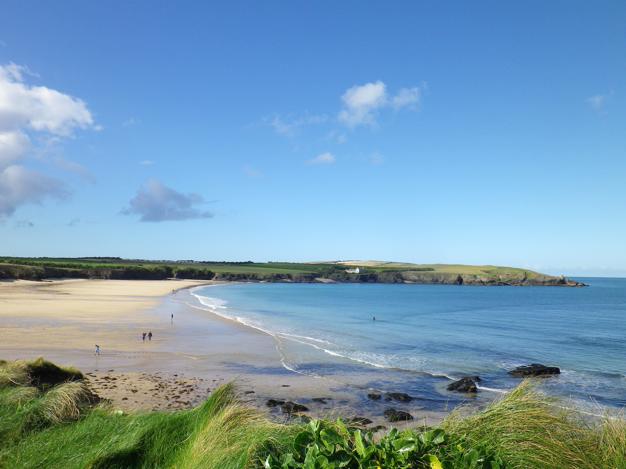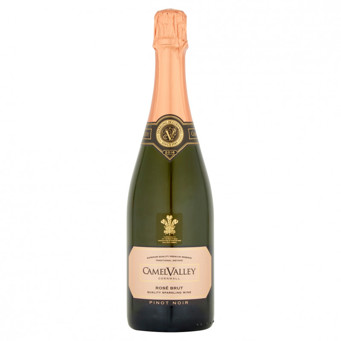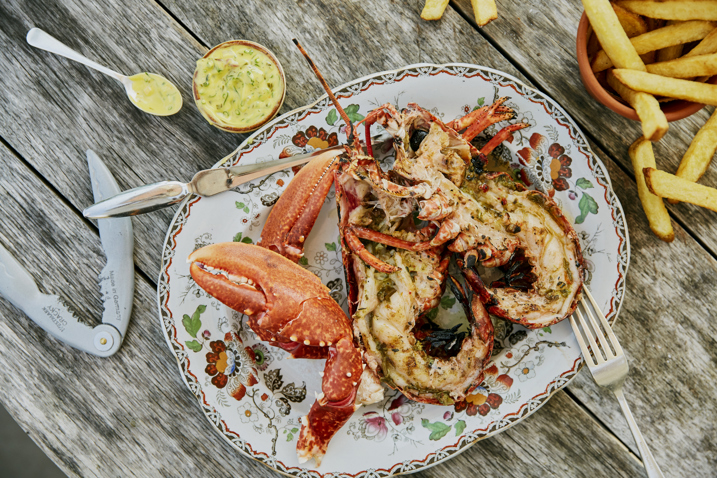We suspect this combo of Lobster and Chips was invented in the US, but at the risk of upsetting the rest of the world, we think the most delicious, sweetest lobsters come from around UK shores. There’s something about eating seafood in sight of the sea that just feels right. Robin (the man behind THE PIGs) says he doesn’t really want to eat seafood if he can’t see the water at the same time! At THE PIG-at Harlyn Bay, the Cornish coast is within casting distance of the hotel, and a fresh catch can be in our kitchen within an hour of being caught and end up on your plate the same day. You won’t find better-tasting lobsters anywhere!

Camel Valley vineyard has been producing award-winning, world-class wines in a beautiful corner of Cornwall since 1989, and it is just 16 miles from THE PIG-at Harlyn Bay. What is it that makes their wines so good? It’s really quite simple – an idyllic setting on sun-drenched slopes near the famous Camel River; excellent grapes that perfectly suit the soil and climate; a respect for traditional vineyard practices combined with a modern approach to wine making and, a passion for creating wines that provide pure pleasure!
So what could be better than local Lobster and Chips with a glass of Camel Valley - all to be enjoyed with a view of Harlyn Bay!
We love Camel Valley Pinot Noir Rosé Brut with our Lobster; in 2017 The Times reviewed it as England’s best pink bubble, made in a pretty corner of the Cornish countryside. It’s a constantly classy, champagne-method gem and bursts with zingy crushed-strawberry fruit. Wander to the park with this and have a wonderful time.

Lobster & thrice-cooked chips, paired with Camel Valley Pinot Noir Rosé Brut

Serves 2
For the chips
• 1-2 Maris Piper potatoes per person (depending on size)
• vegetable or sunflower oil (to fill a deep-fat fryer or chip pan)
For the lobster
• 1 medium-sized lobster
• forager's butter (see below)
• forager's mayo (see below)
• salt and pepper
For the court bouillon
• 150ml (5fl oz) white wine
• 150ml (5fl oz) white wine vinegar
• 150ml (5fl oz) water
• 1 garlic clove
• 1 sprig of thyme
• 1 sprig of tarragon
• 10 peppercorns
For the chips... you’ll need to start your prep the day before you plan to cook. Cut a small slice from one side of each potato and place the cut side down on the chopping board. This should mean the potato is now nice and stable and won’t roll around as you try to chop it. Cut lengthways into 1cm (½ inch) slices, while keeping the potato together. Lay these down on their flat side, and cut into chips 1cm (½ inch) wide. Place the chips in a bowl and cover with cold water. Then put them in the refrigerator overnight to release the starch.
On day 2 (eating day!), drain off the water and rinse quickly.
For the first cook, steam the chips for 8 minutes using a double boiler pan or an electric steamer. You want them to part-cook, so you get that nice, fluffy texture inside. Plunge them into some cold water to chill, then drain and lay them on kitchen paper to soak up any excess moisture. They’ll spit once they get in the fryer if there’s too much water in them.
Preheat the oil in a deep-fat fryer to 120°C (250°F).
For the second cook, blanch the chips in the hot oil for 8–10 minutes, then chill them. When you’re ready to eat, preheat the oil in the deep-fat fryer to 180–190°C (350–375°F), and fry the chips until golden brown and crispy. Season and serve. They need to be eaten on the day of cooking and can’t be reheated, but in our experience that doesn’t tend to be a problem…
Cut the lobster in half, remove the roe, brains and intestinal tubes. Remove the claws.
Make a court bouillon by putting all the ingredients for it in a pan and bringing to a simmer. Cook the claws in the court bouillon for 5 minutes. Set them aside on a plate, keeping the stock hot.
Preheat the oven to 200°C, 180°C fan (400°F), Gas Mark 6. Season and griddle the flesh side of the lobster halves in a hot griddle pan until dark lines are formed on the tail meat.
Put the lobster on a tray, top with forager's butter and bake for 3–5 minutes, depending on size.
Reheat the claws in the court bouillon for 1 minute, crack with the back of your knife and serve with forager’s mayo
Forager’s Butter
Makes 250g (9oz)
• a small handful of:
dandelion leaves
daisy petals
wild sorrel
wild garlic
yarrow
nettles
• zest of 1 lemon
• pepper dulse seaweed, washed thoroughly
• 250g (9oz) good-quality local butter, softened
• salt and pepper
Gently wash the foraged leaves, except the nettles, and the pepper dulse seaweed and pat dry with kitchen paper. Finely chop the leaves. Again, don’t stress too much about varieties and quantities. Blanch the nettles (as in the recipe for Foragers Mayo below) and finely chop.
Stir all the ingredients together with a wooden spoon and season to taste.
On a flat surface, spread out a double layer of clingfilm and tip your forager’s butter onto it. Form the butter into a fat sausage shape, roll it up tightly and tie the ends. Chill in the refrigerator until firm.
Forager's Mayo
Makes 350g (12oz)
• a small handful of:
marigold petals
wild sorrel
wild garlic
yarrow
nettles
• zest of 1 lemon
• 250g (9oz) good-quality mayonnaise (we use Fussels Classic)
• salt and pepper
Gently wash the foraged leaves, except the nettles, and pat dry with kitchen paper. Bring a pan of water to the boil, and using tongs, drop the nettles in. Use a slotted spoon to lift the nettles out of the water as soon as they wilt (about 30 seconds or so).
Dunk the nettles in iced water, swish them around until they’re fully cooled off, then finely chop. Finely chop the other leaves, then mix all the ingredients together and season
to taste.
For more recipes, how-tos and tips why not pick up a copy of THE PIG Book: Tales and Recipes from the Kitchen Garden and Beyond.


